
In 1984, the International Organization for Succulent Plant Study set up a working party, now called the International Cactaceae Systematics Group, to produce a consensus classification of the cactus family, down to the level of genus. Their classification has been used as the basis for systems published since the mid-1990s. Treatments in the 21st century have generally divided the family into around 125–130 genera and 1,400–1,500 species, which are then arranged in a number of tribes and subfamilies. However, subsequent molecular phylogenetic studies have shown that a very high proportion of the higher taxa are not monophyletic, i.e. they do not contain all of the descendants of a common ancestor. As of August 2023, the internal classification of the family Cactaceae remained uncertain and subject to change. A classification incorporating many of the insights from the molecular studies was produced by Nyffeler and Eggli in 2010.
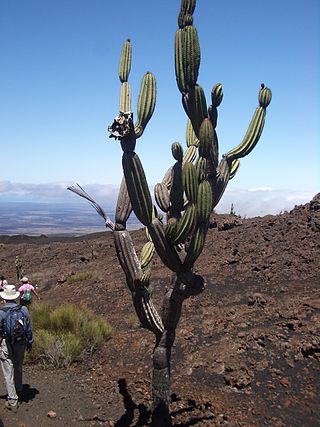
Jasminocereus is a genus of cacti with only one species, Jasminocereus thouarsii, endemic to the Galápagos Islands, territorially a part of Ecuador. In English it is often called the candelabra cactus. At maturity it has a branched, treelike habit, and may be up to 7 m (23 ft) tall. The stems are made up of individual sections with constrictions between them. Its creamy white to greenish flowers open at night and are followed by greenish to reddish fruits.

Neoraimondia is a genus of medium to large cacti from Peru. The genus is named after the Italian-born Peruvian explorer, naturalist, and scientist, Antonio Raimondi.

Savannas Preserve State Park is a Florida State Park, located along much of the Atlantic Coast between Fort Pierce and Jensen Beach. Savannas Preserve also has a group of youth volunteers, the Junior Friends of Savannas Preserve State Park.

Aporocactus martianus is a species of cactus found in Oaxaca, Mexico.

Cereus repandus, the Peruvian apple cactus, is a large, erect, spiny columnar cactus found in South America. It is also known as giant club cactus, hedge cactus, cadushi, and kayush.

Harrisia aboriginum, the west-coast prickly apple or prickly applecactus, is a species of columnar cactus endemic to peninsular Florida, on the Gulf Coast of the counties of Lee, Sarasota County, and Charlotte. Only 12 occurrences are known, and the species is threatened by horticultural collection, shading from fire suppression, competition from invasive flora, and most of all habitat destruction. It is a federally listed endangered species of the United States.
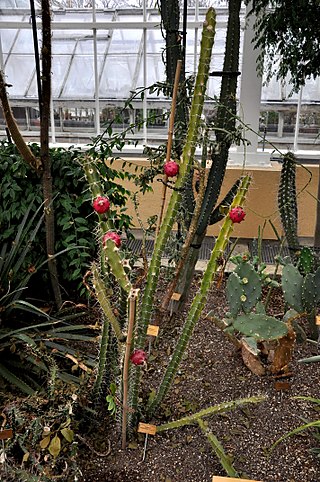
Harrisia bonplandii is a species of cactus. The cactus plants in the Gran Chaco are generally called tuna and this specific variety reina de la noche. Fruits and roots are edible and well known to the native nations of the Gran Chaco.

Harrisia gracilis is a species of cactus found in Jamaica.

Harrisia martinii, commonly called the Martin applecactus, is a species of night-blooming, rope-like cacti native to South America. With large showy flowers that attract the hawk moth, it is considered by some a useful landscape plant in areas that do not freeze.
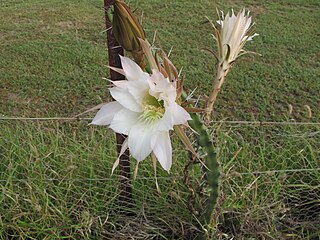
Harrisia pomanensis is a species of cactus.

Harrisia portoricensis is a species of cactus in the genus Harrisia. Its common names include higo chumbo and Puerto Rico applecactus.
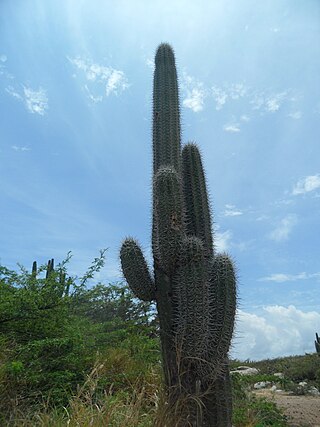
Stenocereus griseus, also known as the Mexican organ pipe, dagger cactus, pitaya, and pitayo de mayo, is a species of cactus.

Clitoria fragrans is a rare species of flowering plant in the legume family known by the common name pigeon wings, or sweet-scented pigeon wings. It is endemic to Central Florida, where it was known most recently from 62 occurrences, but no current estimates of the total global population are available. The plant is a federally listed threatened species of the United States.

Soehrensia candicans is a species of cactus from northern and western Argentina. It has large fragrant white flowers that open at night.

Harrisia tortuosa is a species of cactus in the Trichocereeae tribe.

Cleistocactus smaragdiflorus is a species of Cleistocactus found in Bolivia and Argentina.
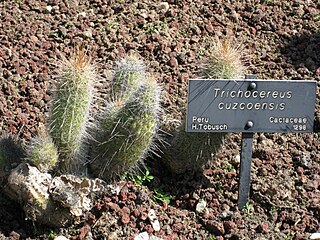
Echinopsis cuzcoensis is a species of Echinopsis cactus found in Peru.
Harrisia adscendens is a species of cactus found in Brazil.




















